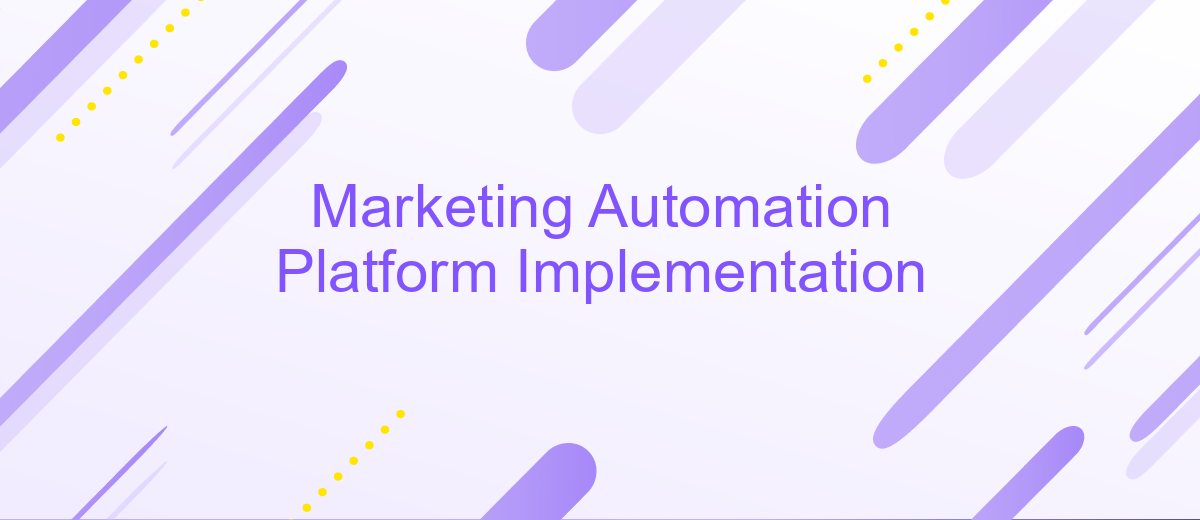Marketing Automation Platform Implementation
Implementing a marketing automation platform is a transformative step for businesses seeking to enhance efficiency and drive growth. By streamlining repetitive tasks and providing valuable insights into customer behavior, these platforms empower marketing teams to focus on strategy and creativity. This article explores the key steps and considerations involved in successfully integrating a marketing automation platform, ensuring a seamless transition and maximizing return on investment.
Introduction
In today's fast-paced digital landscape, businesses are constantly seeking ways to optimize their marketing efforts and enhance customer engagement. Implementing a marketing automation platform is a strategic move that can significantly streamline marketing processes, improve efficiency, and drive better results. By automating repetitive tasks, businesses can focus on crafting personalized experiences for their customers, ultimately leading to increased satisfaction and loyalty.
- Streamlined workflows and task automation
- Enhanced data analysis and reporting capabilities
- Improved customer segmentation and targeting
- Increased efficiency in lead nurturing and conversion
- Personalized customer experiences at scale
As organizations embark on the journey of marketing automation platform implementation, it is crucial to understand the challenges and opportunities that come with it. Proper planning and execution are essential to ensure a seamless transition and maximize the platform's potential. By leveraging the right tools and strategies, businesses can not only achieve their marketing goals but also gain a competitive edge in the ever-evolving market. This introduction sets the stage for exploring the intricacies of successful implementation and the transformative impact it can have on marketing operations.
Benefits and Use Cases

Implementing a marketing automation platform offers numerous benefits, including increased efficiency and improved customer engagement. By automating repetitive marketing tasks such as email campaigns, social media posting, and lead nurturing, businesses can save valuable time and resources. This allows marketing teams to focus on strategy and creativity, rather than manual processes. Additionally, automation platforms provide valuable insights through analytics, enabling businesses to make data-driven decisions and optimize their marketing strategies for better results.
One compelling use case for marketing automation is personalized customer journeys. By leveraging data collected from various touchpoints, businesses can create tailored experiences for each customer, enhancing satisfaction and loyalty. Integration with services like ApiX-Drive can further streamline processes by connecting different applications and automating data flows between them. This ensures seamless communication across platforms, reducing the risk of errors and enhancing overall efficiency. Ultimately, a well-implemented marketing automation platform can drive growth, improve ROI, and provide a competitive edge in today's fast-paced digital landscape.
Key Features to Consider

When implementing a marketing automation platform, it is crucial to identify the key features that will best serve your business needs. These features not only streamline marketing processes but also enhance customer engagement and boost overall efficiency.
- Integration Capabilities: Ensure the platform can seamlessly integrate with existing tools such as CRM systems, social media, and analytics software.
- Personalization and Segmentation: Look for features that allow for advanced segmentation and personalized content delivery to target specific audience groups effectively.
- Analytics and Reporting: Comprehensive reporting tools are essential for measuring campaign performance and making data-driven decisions.
- Automation and Workflow Management: The platform should offer robust automation features to manage repetitive tasks and streamline workflows.
- Scalability: Choose a platform that can grow with your business, accommodating increased data and user demands over time.
By focusing on these key features, businesses can ensure a successful implementation of a marketing automation platform, leading to improved marketing strategies and enhanced customer relationships. Investing in the right features will pave the way for long-term growth and competitive advantage.
Implementation Considerations

When implementing a marketing automation platform, it's crucial to align the platform's capabilities with your business objectives. Start by identifying your key goals, whether it's lead generation, customer retention, or brand awareness. This alignment ensures that the platform supports your strategic initiatives effectively.
Next, consider the integration with existing systems. Seamless data flow between your marketing automation platform and CRM, ERP, or other software is vital for a unified customer view. Evaluate the compatibility and data synchronization capabilities to avoid data silos and ensure accurate reporting.
- Define clear objectives and KPIs to measure success.
- Ensure team readiness through training and support.
- Evaluate data privacy and compliance requirements.
- Test and iterate the platform for optimal performance.
Finally, focus on user adoption and ongoing optimization. Encourage team collaboration and regular feedback to refine strategies and improve platform utilization. Continuous monitoring and adjustment will help in maximizing the return on investment and achieving long-term success.
Best Practices and Tips
When implementing a marketing automation platform, it's crucial to start by defining clear goals and objectives. This ensures that all efforts align with your business strategy and desired outcomes. Conduct a thorough audit of your current marketing processes to identify areas that can benefit from automation. Engage stakeholders early in the process to gather insights and foster collaboration across departments. This collaborative approach ensures that the platform meets the needs of all users and maximizes its potential.
Integration is a key aspect of successful implementation. Utilize tools like ApiX-Drive to seamlessly connect your marketing automation platform with existing systems, such as CRM and analytics tools. This integration enables data synchronization, providing a holistic view of customer interactions and enhancing decision-making. Additionally, prioritize training and support for your team to ensure they are proficient in using the platform. Regularly review performance metrics to identify areas for improvement and adapt your strategy as needed. By following these best practices, you can optimize your marketing automation efforts and drive significant business growth.
FAQ
What is a Marketing Automation Platform (MAP) and why do I need it?
How do I choose the right Marketing Automation Platform for my business?
What are the common challenges when implementing a Marketing Automation Platform?
How can I integrate my existing systems with a Marketing Automation Platform?
What metrics should I track to measure the success of my Marketing Automation efforts?
Time is the most valuable resource for business today. Almost half of it is wasted on routine tasks. Your employees are constantly forced to perform monotonous tasks that are difficult to classify as important and specialized. You can leave everything as it is by hiring additional employees, or you can automate most of the business processes using the ApiX-Drive online connector to get rid of unnecessary time and money expenses once and for all. The choice is yours!

